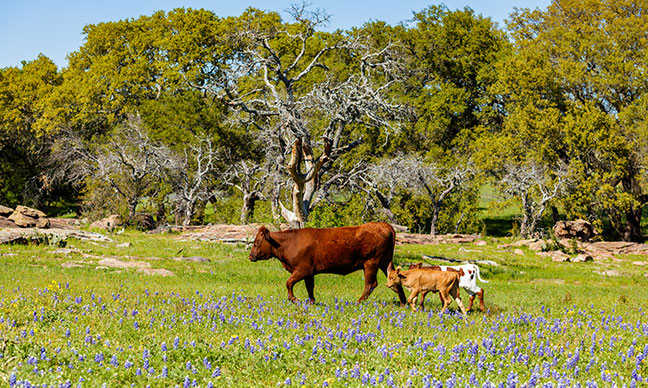Oaks are very important to the culture and landscape in the Lonestar state, and residents are well-aware of this. These majestic, stately Oak trees in Texas can be found in every part of the state, and they usually provide shelter for local wildlife, plenty of shade for residents, and useful acorns for everyone. Still, with over 60 different species, it can be hard to determine which ones are the best for you.
Keep reading to find out what Texas oak tree would be the perfect fit for you!
Related Post: Best Time To Plant Trees In Texas
Oak Trees in Texas – Common Varieties
1. Red Oak
Red oak is a fast-growing tree native to the area. It is fiery and spiked, often planted as an ornamental tree for its beautiful autumn color. This deciduous broadleaf tree has a rounded crown and provides lots of shade for the owners. The bark is silver-grey and very smooth when young, and it develops ridges and wards with age. Twigs are dark brown, slender, and straight. The leaves are quite long and the tree is easily identified in winter by the long buds.
At maturity, Red oak can grow to about 80 feet in height in the optimal environment. It is a very popular nesting tree for pollinators and birds, but it isn’t as valuable to wildlife as some other native oaks. Also, this tree is less susceptible to pathogens and trees than some other Oak trees in Texas according to tree services Texas.
2. Mexican Oak
Mexican oak is an incredible tree recommended to landscape planners. Besides, it is one of the most common shade trees for Austin and a “University favorite”. The tree is perfectly adapted to the hardiness zone in Texas, giving you another reason why it a great Texas oak tree. The leaves are about 5 inches long and have serrated or smooth edges of varying degrees. Different specimens have different leaf shapes.
Once it hits maturity, this tree can grow to about 40 feet in height. The great thing about it is that Mexican oaks are fast-growers, which is one of the reasons why they are particularly desirable to have in landscapes. Also, this tree is more successful in oak wilt treatment than other oak tree varieties.
3. Live Oak
Live oak is a magnificent, broadleaf evergreen tree that’s always a great addition to a residential landscape. Also, it is commonly used as a street tree in some Texas cities too. This tree features leathery leaves that can be up to 5 inches long. They have a glossy, dark green color on top and a paler underside usually covered with fine down. The tree grows in a rounded shape and is commonly used as a Texas shade tree in landscapes.
Related Post: Evergreen Trees Texas
This tree grows to about 80 feet in height at maturity in the optimal environment. It has a moderately fast growth rate, making it even more desirable for residential use. The tree produces green acorns that turn dark brown at maturity. Interestingly, Live oaks in Lubbock are one of the most valuable trees in the whole state.
4. Lacey Oak
Lacey oak is a tree with erected branches and, in some cases, with multiple trunks. It has thick, oblong, deciduous leaves with shallow lobes. During fall, the foliage is peach-colored, but it dents to be grayish-green or dark-blue in summer. One of the characteristics of this tree is that its summer foliage tends to take on a smokey appearance.
Lacey oak is considered a medium-sized tree, growing to about 60 feet in height at maturity. The tree provides cover and food for birds, small mammals, and deer, so keep that in mind if you plan to plant on your property. Tree service Texas companies recommend planting this tree in limestone and dry soil.
6. Chinquapin Oak
Chinquapin oak is a very worth specimen for parks and large yards or lawns. Its glistering dark green leaves turn orangish-brown in fall, providing interesting scenery during this period. The park has a light gray color and it breaks into thin, narrow flakes. The tree becomes a conversation piece and a magnificent specimen as it gets older, which is why it is usually recommended for residential use.
At maturity, this tree can grow to about 50 feet in height in the optimal environment. Also, the tree produces acorns that mature in just a single season and are a common food preference for different types of birds and other wildlife. Experts say that this Texas oak tree is adaptable to different types of soil as long as it is well-drained. Full sun exposure is recommended for the best results.
FAQ
Q: How do I identify oak trees in Texas?
A: You have to look at the flower buds during spring to identify oak trees in Texas. Most oaks have green catkins that are usually 1-4 inches long. The Texas red oak has reddish-brown catkins, Shumard oak has brown, and the live oak has yellow catkins.
Q: How do I identify an oak tree?
A: The best thing you can do is to look at the flower buds to identify an oak tree in Texas. Usually, oak trees have catkins that are about 4 inches in length. Different varieties will have different looking catkins, so we recommend learning about them to be able to identify the oak tree.
Q: What oak trees symbolize?
A: The oak usually symbolizes endurance and strength in Texas. This tree has been chosen as the national tree in many countries due to these symbols. These symbols have been used for centuries. In some countries, oaks are used to confer power and heritage.
Local Tree Experts Overview
Oak trees in Texas are commonly used in both residential and urban landscapes. They provide lots of shade, ornamental features, and can even serve as windbreaks. We recommend planting them, just make sure to consult with your local arborist regarding potential diseases or pests that are common for Oak trees in the Texas area.




